Sounds simple? Do it right and keep your stress minimal! Here are all the steps in how to clean a fish tank:
Simple Steps: How to Clean a Fish Tank
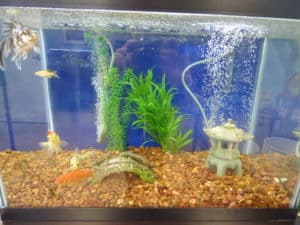
1. Wash your hands and arms to your elbows.
This is critical to ensure any substances on your hands, such as chemicals or moisturizers don’t contaminate your fishes’ water.
2. Unplug filter and lights.
You do not want these to run without water in them since it could damage the mechanical parts. If you have any UV lights, unplug those too. Close any valves if you have a sump so it doesn’t overflow.
3. Remove any synthetic décor.
Take all your décor to the sink and scrub it with hot water and a designated toothbrush. For caked on algae, you can soak your décor in hot, not boiling water, for a few minutes. Do NOT use any detergent!
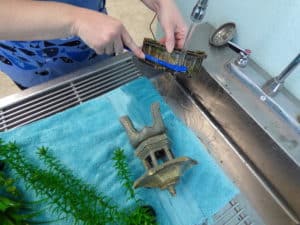
4. Clean the glass with an appropriate acrylic-safe or glass scrub.
It is critical that you use a scrubber that is appropriate for your tank type. Glass scrubs are more abrasive and can scratch acrylic, causing a hazy appearance. If you are unsure, it is better to choose one for acrylic.
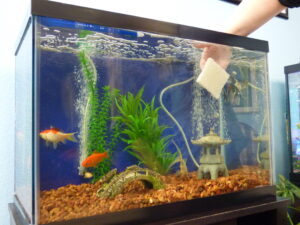
5. Use a gravel vacuum to get into the substrate crevices.
This is the most important step in how to clean your fish tank. Removing fish waste and excess food has the biggest influence on your tank’s water quality. Press the end of the siphon into the substrate, allow the gravel or sand to move 1/4 to 1/3 of the way up the tube, then pull the siphon up, breaking the siphon. Your substrate will fall back down and the loose debris will get sucked down the hose.
Do not remove more than 50% of the tank water at a time to avoid sudden swings in temperature and pH. Pay close attention to your bucket collecting waste tank water as well! When it gets within 3″ of the top, pull the siphon all the way out. Your fish can stay in the tank during cleaning, just keep an eye on them and don’t suck them up!
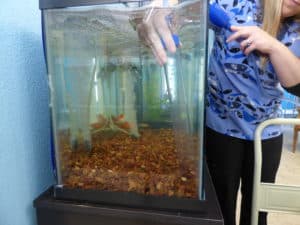
6. Remove filter media and rinse gently or squeeze in collected bucket of waste water.
Do NOT use tap water. The chlorine in tap water that makes it safe for us to drink kills your good bacteria. Please note: your filter media WILL NOT have to be pristine and sparkling. Again, super clean media will reset your biologic filter to ZERO. You do NOT have to replace your filter media every month (we know it says so on the box, please disregard!) If your filter media is falling apart, do not replace more than 1/4-1/3 of the total media at a time. We recommend using sturdy sponges over floss. Use your waste water to feed your plants. (The nitrates make great fertilizer!)
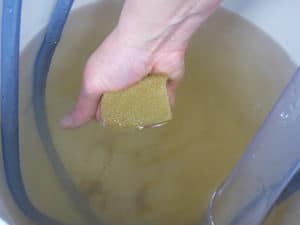
8. Re-fill your bucket with tap water.
Bottled water can be missing buffers and/or minerals, but some tap water may not be sufficient. If you never have, test your tap water pH and KH. You may need to use another water source or add in some buffers in order to correct it for your fish needs.
Make sure your new water is the same temperature as your tank! An infrared thermometer is great for quickly comparing two temperatures without contaminating either source. You may already have one in your kitchen or with your grilling equipment.
9. Add dechlorinator to your bucket of water and décor that treats chlorine AND chloramine.
Another critical step in how to clean a fish tank correctly! There are MANY commercial products available for this purpose and there is no one that is better than others. Chloramine is a more stable form of chlorine mixed with ammonia, so ensure it says it treats both on the label. Measure out enough to treat the volume of water you are adding and allow at least a minute for the dechlor to do its job.
If you have a very large tank and don’t want to treat separately, take the total dose of dechlorinator and divide it into 3 or 4 smaller doses. Add the first dose before you start adding water and then the rest in increments as you fill up the tank.
10. Replace your décor back in your tank and pour in your treated water.
Be sure to poor slowly or use a smaller vessel to move water between your filled bucket and your tank to avoid a heavy current in your tank that may hurt your fish. You may need to adjust your décor after adding the water.
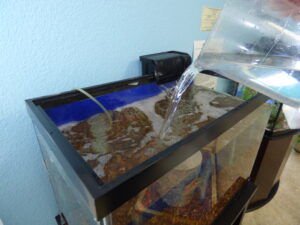
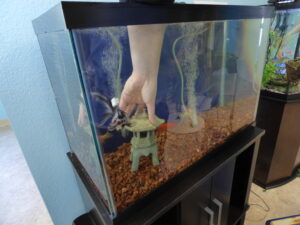
11. Prime your filtration by pouring some tank water into the filter base.
Priming your hang-on-back filters can be done by taking a cup of water and pouring it into the larger reservoir. Canister filters may have a priming operation or need water forced down the intake. Plug in and adjust flow accordingly. Open any valves you previously closed on your sump and other filtration.
12. Turn on your lights and replace any covers.
Watch your tank for a few minutes to make sure everything is working properly. Pay close attention to your fish to ensure everyone is acting normal after the water change. Listen to your filtration to ensure it sounds correct.
And lastly – wash your hands and arms! There are very few diseases that have the potential to pass between you and your fish, but let’s cut the odds to zero. Tah dah! You have successfully learned how to clean a fish tank.
Watch this video for the entire how to clean a fish tank process.
Troubleshooting How to Clean a Fish Tank
Everything is so LOUD after I clean!
This is probably due to air stuck in your filtration, causing the pumps to work extra hard. This may go away after a few minutes, or you should take more care in re-priming your filtration. If you are unsure if your filter should or needs to be primed, contact the manufacturer.
My fish seem to be breathing extra heavy after cleanings.
This is an indication that your fish are trying to regulate the new incoming water, meaning you have an issue with your water quality! Test your tank and tap water parameters to ensure they match before adding new water. If you have a pH that is greater than 2.0 from the source, contact your veterinarian for detailed instructions.
I can’t get rid of all this algae no matter how much I clean!
Good!! Algae is a sign that your tank is healthy. Do not worry about getting rid of every molecule of it; you’ll never win! Algae bothers people a million times more than the fish. Unless your tank is pea soup green or your fish cannot swim through, do not worry about it.

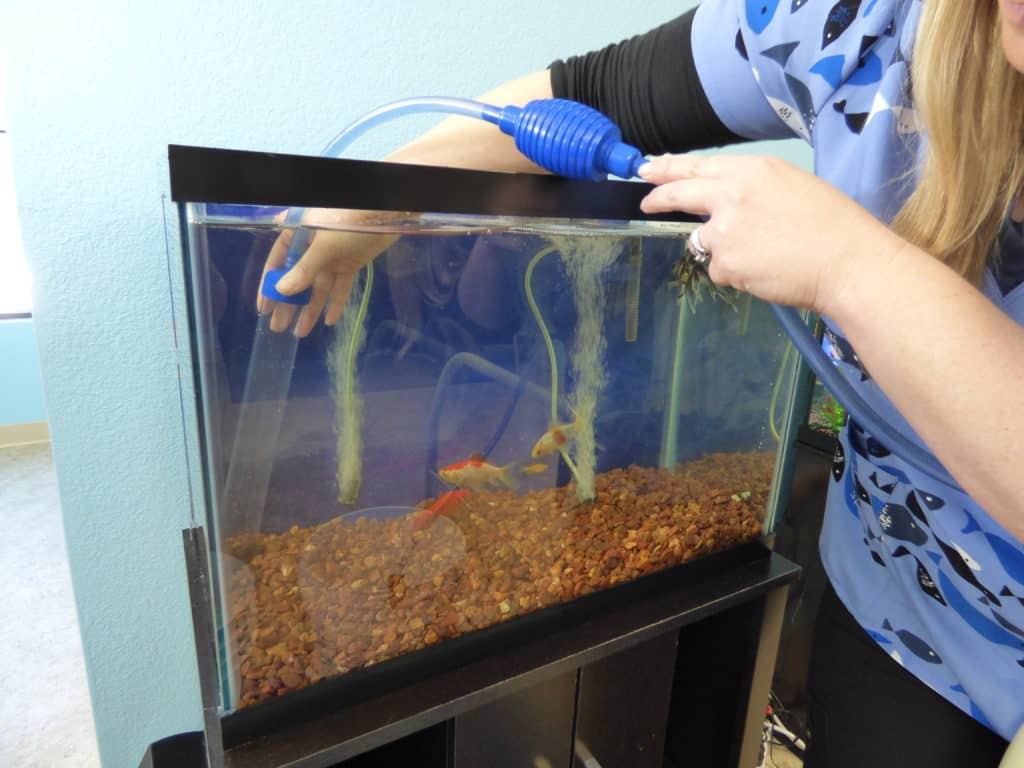
I would like to nominate you for the Liebster Award. For more information visit my article “and the nominees are…” for more information. Please keep writing and sharing your insight!
Pingback: New Tank Checklist – Aquatic Veterinary Services
Pingback: How To Setup A New Fish Tank – Aquatic Veterinary Services
Pingback: Don’t Flush That Fish! – Aquatic Veterinary Services
How To Clean A Fish Tank- a guide to assist any aquarist in the regular maintenance efficient routine cleaning of fresh or saltwater tanks.
Pingback: Best 15 how to clean a fish tank without a gravel vacuum - bryanadvisors.com
Hello.
Thank you for the insightful article, I particularly liked that how to clean both a freshwater and saltwater fish tank was explained! If your readers are keen to know how often their fish tanks should be cleaned, we’ve also written a blog post on how to clean a fish tank that they may want to read, here: https://blog.sweepsouth.com/how-to-clean-a-fish-tank/
Thanks for the useful tips Jessie! We’ve also written an article with some insightful information if your readers are interested in having a look at: https://blog.sweepsouth.com/how-to-clean-a-fish-tank/
Pingback: ¿Por qué los pescados de Oscar tiemblan? (5 razones comunes)
Pingback: Why Are Goldfish Fins Turning Black: 5 Reasons & Fix
Pingback: 5 Tip & Tricks You Should Follow When You Inject CO2
Pingback: How To Clean A Fish Tank? Complete Guide To Clean
Pingback: How to Change Water in Fish Tank: A Step-by-Step Guide - Epic Fish Tank
Pingback: هل سمك الزينة يكبر (2024) – Nabd Beirut
Pingback: Petco Cichlids: Discover Stunning